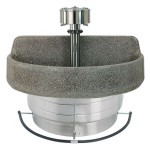How To Install Tile Behind Bathroom Sink
Installing tile behind a bathroom sink is a relatively straightforward DIY project that can significantly enhance the look and feel of your bathroom. It's a great way to add a touch of elegance, protection, and easy-to-clean surfaces. This comprehensive guide will walk you through the steps involved, from preparation to finishing touches.
1. Preparing the Area for Tile Installation
Before you start tiling, it's crucial to prepare the area properly. This ensures a smooth and successful installation. Here's what you need to do:
- Clear the Area: Remove any fixtures, towel racks, or other items around the sink. This will give you a clear working space.
- Remove Existing Surfaces: If there is existing wallpaper, paint, or tile behind the sink, remove it completely. Use a scraper or a heat gun to loosen the existing material. Be careful not to damage the drywall or the underlying surface.
- Clean the Surface: After removing the old surface, thoroughly clean the area to remove any dirt, dust, or debris. Use a damp cloth and a degreaser to ensure a clean surface for the tile adhesive.
- Patch and Smooth: If the surface has any holes, cracks, or unevenness, patch and smooth them using drywall compound. Allow it to dry completely before proceeding.
2. Measuring and Planning the Tile Layout
A well-planned tile layout is essential for achieving a professional look and maximizing material efficiency. Here are the steps involved in measuring and planning:
- Measure the Area: Accurately measure the width and height of the area where you will be installing the tile. This will help you determine how many tiles you need and how to arrange them.
- Choose a Layout: Choose a layout that suits your style and the size of the area. Common options include:
- Running Bond: A classic layout with straight rows of tiles with staggered joints.
- Brick Pattern: Creates a visually interesting look with tiles offset in alternating rows.
- Herringbone Pattern: Creates a chevron-like pattern with tiles laid at 45-degree angles.
- Mark the Center: Use a level and a pencil to mark the center of the area. This will help you align the tiles evenly.
- Dry Lay the Tiles: Before applying adhesive, dry lay the tiles to visualize the layout and adjust as needed. This step allows you to make sure the tiles fit properly and that you have enough material.
3. Installing the Tile
Once you have prepared the area and planned the layout, you are ready to start installing the tile. This step requires care and precision to ensure a secure and aesthetically pleasing installation. Here's how to proceed:
- Mix the Adhesive: Follow the manufacturer's instructions to mix the tile adhesive to the correct consistency. You should aim for a smooth, spreadable consistency.
- Apply the Adhesive: Use a notched trowel to apply a thin layer of adhesive to the back of each tile. The notch size will depend on the size of the tiles you're using.
- Install the Tiles: Carefully press each tile into place, ensuring that they are level and aligned with the layout marks. Use a level to check for evenness.
- Space the Tiles: Use tile spacers to maintain uniform grout lines between tiles.
- Clean Up: Wipe away any excess adhesive immediately with a damp sponge.
Allow the adhesive to dry fully before moving on to the next step. This will ensure that the tiles are securely in place.
4. Grouting and Finishing
Grouting is the final step in installing tiles. It fills in the gaps between tiles, providing a smooth and finished appearance and sealing the surface against moisture. Here's how to complete the grouting process:
- Mix the Grout: Mix the grout according to the manufacturer's directions. Aim for a consistency that allows it to be easily spread without sagging.
- Apply the Grout: Use a rubber grout float to apply the grout to the gaps between tiles, pressing it firmly into the spaces.
- Clean Excess Grout: Remove excess grout from the tile surface using a damp sponge. Be careful not to disturb the grout lines.
- Allow the Grout to Dry: Allow the grout to dry completely before applying any sealant. This may take several hours or overnight, depending on the type of grout.
- Seal the Grout: Once the grout is dry, apply a sealant to protect it from moisture and stains. This is important for bathroom tiles as they are exposed to moisture and splashes.
After the sealant has dried, you can reinstall your fixtures, such as towel racks and soap dispensers.

How To Install A Tile Backsplash

Tutorial How To Install A Bathroom Vanity The Diy Playbook

Backsplash Advice For Your Bathroom Would You Tile The Side Walls Too Designed

How To Install Backsplash Bathroom Tile Easy Simple

Vanity Tile Backsplash Ideas Monks Home Improvements

Bathroom Design Getting Tile Around The Vanity Right

Small Bathroom Remodel Easy Diy Tile Backsplash Engineer Your Space

Backsplash Advice For Your Bathroom Would You Tile The Side Walls Too Designed

Small Bathroom Remodel Easy Diy Tile Backsplash Engineer Your Space

62 Bathroom Backsplash Ideas For A Stylish Makeover White Subway Tile Vanity Designs







